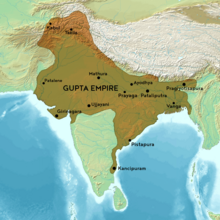Samudragupta's subjugation of the Kushan Empire
Samudragupta's subjugation of the Kushan Empire was between the Indian Emperor, Samudragupta and the remaining Kushans. The Kushan Empire continued as a remnant known as the "Little Kushans", based in the Punjab. Around 270 their territories on the Gangetic plain became independent under local dynasties such as the Yaudheyas. Then in the mid-4th century they were subjugated by the Gupta Empire under Samudragupta.[2] In his inscription on the Allahabad pillar Samudragupta proclaims that the Dēvaputra-Shāhi-Shāhānushāhi (referring to the last Kushan rulers, being a deformation of the Kushan regnal titles Devaputra, Shao and Shaonanoshao: "Son of God, King, King of Kings") are now under his dominion, and that they were forced to "self-surrender, offering (their own) daughters in marriage and a request for the administration of their own districts and provinces".[3][2][4] This suggests that by the time of the Allahabad inscription the Kushans still ruled in Punjab, but under the suzerainty of the Gupta Emperor.[2]
| Samudragupta's subjugation of the Kushan Empire | |||||||||
|---|---|---|---|---|---|---|---|---|---|
| Part of Samudragupta's conquests | |||||||||
 Map of the Gupta Empire c. 420 CE, according to Joseph E. Schwartzberg, with contemporary polities[1] | |||||||||
| |||||||||
| Belligerents | |||||||||
|
|
| ||||||||
| Commanders and leaders | |||||||||
|
|
| ||||||||

Samudragupta's Northwestern Policy
changeThe reconstruction of Samudragupta's northwest policy mentioned earlier aligns with other intriguing facts. In 361 AD, an Indian delegation reportedly visited Rome, as stated by Roman historians. Despite having been dispatched from India earlier, the embassy did not reach Rome until 351 AD. Taking into account the political circumstances in India during the mid-4th century AD, this fact holds significant value. Before the year 361 AD, it was noted that the Roman emperors were engaged in a conflict with the Sassanids. So it was not unexpected for Samudragupta to try to stop future conflicts with the Persian army on the Western Front by allying with Kidara I against Shahpur II. So it is possible that he sent an embassy to Rome before 361 AD.[5]
The Kushan contemporary of Samudragupta, was Kidāra. He was initially a part of the Great Kushan family. It was after him that his individuals got to be celebrated as the small Kushans. Hence, it can be true in a way that he was known to his counterparts as a ruler of the Devaputra family. But he was not effective enough to use the title Shahanushahi. He was simply a Shahi. His coins bearing the legend 'Kidāra Kushāṇa Shāhi' proved it. So, he can clearly be recognized with Daivaputrashāhi of the Allahabad pillar inscription. Here it is curiously to note that opposite to the for the most part acknowledged see, within the Prayaga Prasasti the word Devaputra has not been used as a title, for the reality that it has been used in its taddhita shape not simply appears that it must be taken in conjunction with the another word 'Shāhi', it moreover demonstrates that the compound Daivaputrashahi would connote 'Shāhi, who had a place to (the family of) the Devaputras'. As respects Kidāra's contemporary Shahanushahi, he might have been no other than Shapur II, the Sassanian Shahanshah. On the premise of this proposal the course of history of Bactria and North-Western India may be reproduced as takes after:
Kidara, after having set up himself in Gandhara, apparently at the cost of the Saka rulers, drew closer to Samudragupta a few times after 359 A. D., sent him presents and callings of steadfastness and inquired for his offer of assistance against the Sasanians. Samudragupta, on his part, was exceptionally much on edge to amplify his circle of impact past the central Punjab where his subordinate partners, the Gadaharas, were administering. He saw with uneasiness the tribal developments which were taking place in that heading and were posturing a risk to his recently established domain. But he was not a vanquisher, he was a statesman as well. He knew he possessed impediments and had the intelligence of restoring the prevailed rulers of the South.[8]
He needed to be included in a North-Western experience, indeed less. But, in any case, he was anxious to make the wildernesses of the domain and the western trade-routes secure and secure. He subsequently, did what was the most excellent; beneath the circumstances he concluded an alliance with Kidara and as the more grounded part of the association gave him an offer of assistance against Shapur II. His arrangement was prominently effective and Kidara vanquished the Sasanians twice in 367-68 A. D. It may not suggest that Shapur II got to be a vassal of Kidara or Samudragupta. But it does indicate that the articulation of Harishena about the connection of his master with the Sasanian ruler ought to not be suggested as through and through altogether without foundation.[8]
References
change- ↑ Schwartzberg, Joseph E. (1978). A Historical atlas of South Asia. Chicago: University of Chicago Press. p. 145, map XIV.1 (j); p.25. ISBN 0226742210. Archived from the original on 24 February 2021. Retrieved 12 February 2022.
- ↑ 2.0 2.1 2.2 Dani, Litvinsky & Zamir Safi 1996, pp. 165–166
- ↑ Lines 23-24 of the Allahabad pillar inscription of Samudragupta: "Self-surrender, offering (their own) daughters in marriage and a request for the administration of their own districts and provinces through the Garuḍa badge, by the Dēvaputra-Shāhi-Shāhānushāhi and the Śaka lords and by (rulers) occupying all Island countries, such as Siṁhala and others."
- ↑ Cribb, Joe; Singh, Karan (Winter 2017). "Two Curious Kidarite Coin Types From 3rd Century Kashmir". JONS. 230: 3.
- ↑ Goyal 1967, pp. 179–180.
- ↑ A similar coin with reading of the legend
- ↑ Lerner, Judith A. (210). Observations on the Typology and Style of Seals and Sealings from Bactria and the Indo-Iranian Borderlands, in Coins, Art and Chronology II. The First Millennium CE in the Indo-Iranian Borderlands. Vienna: ÖAW. p. 246, note 7.
- ↑ 8.0 8.1 Goyal 1967, pp. 177–178.